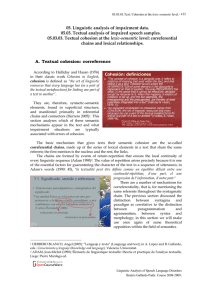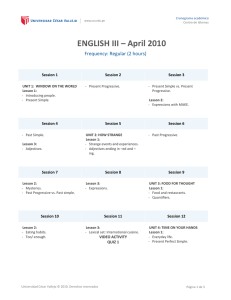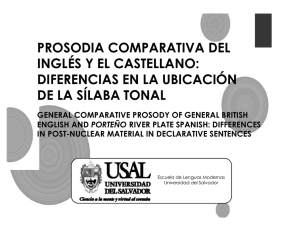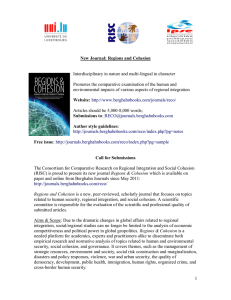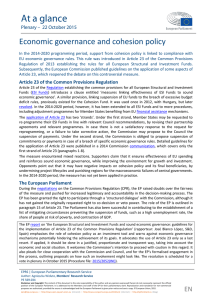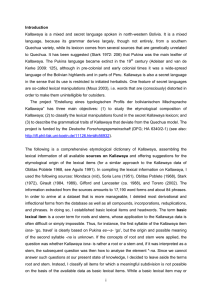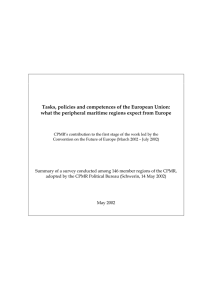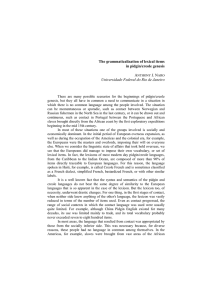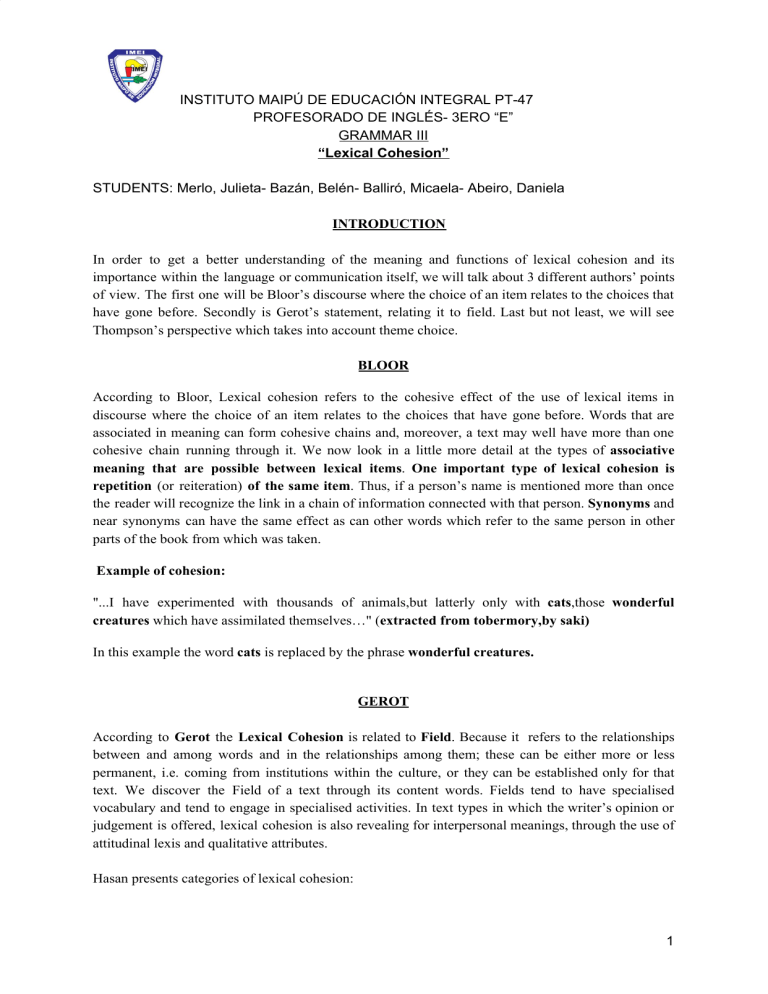
INSTITUTO MAIPÚ DE EDUCACIÓN INTEGRAL PT-47 PROFESORADO DE INGLÉS- 3ERO “E” GRAMMAR III “Lexical Cohesion” STUDENTS: Merlo, Julieta- Bazán, Belén- Balliró, Micaela- Abeiro, Daniela INTRODUCTION In order to get a better understanding of the meaning and functions of lexical cohesion and its importance within the language or communication itself, we will talk about 3 different authors’ points of view. The first one will be Bloor’s discourse where the choice of an item relates to the choices that have gone before. Secondly is Gerot’s statement, relating it to field. Last but not least, we will see Thompson’s perspective which takes into account theme choice. BLOOR According to Bloor, Lexical cohesion refers to the cohesive effect of the use of lexical items in discourse where the choice of an item relates to the choices that have gone before. Words that are associated in meaning can form cohesive chains and, moreover, a text may well have more than one cohesive chain running through it. We now look in a little more detail at the types of associative meaning that are possible between lexical items. One important type of lexical cohesion is repetition (or reiteration) of the same item. Thus, if a person’s name is mentioned more than once the reader will recognize the link in a chain of information connected with that person. Synonyms and near synonyms can have the same effect as can other words which refer to the same person in other parts of the book from which was taken. Example of cohesion: "...I have experimented with thousands of animals,but latterly only with cats,those wonderful creatures which have assimilated themselves…" (extracted from tobermory,by saki) In this example the word cats is replaced by the phrase wonderful creatures. GEROT According to Gerot the Lexical Cohesion is related to Field. Because it refers to the relationships between and among words and in the relationships among them; these can be either more or less permanent, i.e. coming from institutions within the culture, or they can be established only for that text. We discover the Field of a text through its content words. Fields tend to have specialised vocabulary and tend to engage in specialised activities. In text types in which the writer’s opinion or judgement is offered, lexical cohesion is also revealing for interpersonal meanings, through the use of attitudinal lexis and qualitative attributes. Hasan presents categories of lexical cohesion: 1 INSTITUTO MAIPÚ DE EDUCACIÓN INTEGRAL PT-47 PROFESORADO DE INGLÉS- 3ERO “E” GRAMMAR III “Lexical Cohesion” STUDENTS: Merlo, Julieta- Bazán, Belén- Balliró, Micaela- Abeiro, Daniela ● Repetition Repetition of a lexical item is the most used form of lexical cohesion; e.g. dog in “Reza saw a dog. The dog was wounded by the children.” In order for a lexical item to be recognized as repeated its need not be in the same morphological shape. Ali arrived yesterday. His arrival made his mother happy. Arrived, arriving,and arrival are all the same item, and occurrence of any one constitutes a repetition of any of the others. Inflectional and derivational variants are also as the same item. ● Synonymy Lexical cohesion is also created by the selection of a lexical item that is in some sense synonymous with a preceding one. What people want from the government is frankness. They should explain everything to the public. ● Hyponymy (Specific – General) Hyponymy is a relationship between two words, in which the meaning of one of the words includes the meaning of the other words. For example, the words, animal and dog are related in such a way that dog refers to a type of animal, and animal is a general term that includes dog as well as other types of animals. A dog is a symbol of loyalty. That animal is mine. ● Meronymy (Part – Whole) In this kind of lexical cohesion, cohesion results from the choice of a lexical item that is in some sense in part-whole relationship with a preceding lexical item. An English daily Monday talked about the result of the presidential election. The editorial described that pre-election speeches caused good results. ● Antonymy In this type of lexical cohesion, cohesion comes about by the selection of an item which is opposite in meaning to a preceding lexical item. Ali received a letter from the bank yesterday. He will send answer next day. ● General Nouns 2 INSTITUTO MAIPÚ DE EDUCACIÓN INTEGRAL PT-47 PROFESORADO DE INGLÉS- 3ERO “E” GRAMMAR III “Lexical Cohesion” STUDENTS: Merlo, Julieta- Bazán, Belén- Balliró, Micaela- Abeiro, Daniela The general nouns including thing, person, do,… are used cohesively when they have the same referent as whatever they are presupposing. Saddam doesn’t approve military action against Iraq. He said that the moves were illegal. ● Collocation This type of lexical cohesion results from the association of lexical items that regularly cooccur. Or as Yarmohammadi (1995, p.127) believes collocation is achieved “through the association of lexical items that regularly tend to appear in similar environments. Such words don’t have any semantic relationship”. Beham considers collocation as “collocation is one of the factors on which we build our expectations of what is to come next.” An example of collocation is as the following: A huge oil boat polluted the sea. Many dead fishes lie along the beach. THOMPSON The speaker helps the hearer to perceive the coherence of the text by organizing the way in which the meanings are expressed. So, we will develop on one of the main ways of doing this: Theme choice. It directly affects the structure of the clause itself. According to Thompson, he has used both ‘cohesion’ and ‘coherence’ in talking about texts, and the terms may seem almost interchangeable and there is an important difference between them: ● Cohesion refers to the linguistic devices by which the speaker can signal the experiential and interpersonal coherence of the text, and is thus a textual phenomenon – we can point to features of the text that serve a cohesive function. ● Coherence, on the other hand, it is a mental phenomenon process and cannot be identified or quantified in the same way as cohesion. In addition, it is in the mind of the writer and reader. It’s good to know that Cohesion and Coherence are in most cases linked, in that a text that exploits the cohesive resources of the language effectively should normally be perceived as coherent. Now, let’s look at and analyze the example below: E.g. Hugo spent all of his legacy laying down wine. He was ensuring a happy middle age. According to Thompson, these sentences have only one cohesive link: ‘Hugo’ in the first sentence is referred to as ‘He’ in the second, but they make sense together. 3 INSTITUTO MAIPÚ DE EDUCACIÓN INTEGRAL PT-47 PROFESORADO DE INGLÉS- 3ERO “E” GRAMMAR III “Lexical Cohesion” STUDENTS: Merlo, Julieta- Bazán, Belén- Balliró, Micaela- Abeiro, Daniela Then, the textual metafunction organize the message and express if they are coherent (although you might like to consider what cultural knowledge the reader needs in order to reconstruct the coherence) However, cohesion is a crucial linguistic resource in the expression of coherent meanings. Besides, the analyst may gain equally important insights into how it works from cases where a lack of cohesive devices in a text does not lead to the interactants perceiving it as incoherent. Cohesion and register According to a short extract from a textbook (Evolution, Prentice Hall Science, 1994), we can get an idea of how cohesion operates in different registers. It is a very good example which has been chosen because the cohesive signals are unusually (even abnormally) dense and explicit in some ways but not in others. Look at the example below: “(1) Today, scientists know that chromosomes play an essential role in heredity. (2) Chromosomes control all the traits of an organism. (3) How do they perform this complex task? (4) The main function of chromosomes is to control the production of substances called proteins. (5) All organisms are made up primarily of proteins. (6) Proteins determine the size, shape, and other physical characteristics of an organism. (7) In other words, proteins determine the traits of an organism. (8) The kind and number of proteins in an organism determine the traits of that organism. (9a) So by controlling the kind and number of proteins produced in an organism, (9b) chromosomes are able to determine the traits of that organism.” According to Thompson, the analysis below develop many features as possible that contribute to the cohesion. The sentences are numbered for ease of reference: ➔ The most striking feature of the text is its lexical explicitness. This comes out especially in the reliance on lexical repetition rather than reference items such as pronouns. ➔ Apart from ‘they’ in (3), the main participants (chromosomes, proteins, organisms) are always referred to by full nominal groups; and there is also obvious repetition of the near-synonyms for the main process, ‘control’ and ‘determine’. ➔ This is most evident in (6), (7) and (8), in which ‘the size, shape, and other physical characteristics’ becomes ‘the traits’, and then ‘The kind and number (of proteins)’ is added; but there is a similar relationship between (2) and (9b) and between (4) and (9a). ➔ Interestingly, this high degree of lexical repetition seems to leave very little need for cohesive use of demonstratives: ‘the’ is always used to point forward to a postmodifying prepositional phrase within the same nominal group, not to signal anaphorically that a participant has 4 INSTITUTO MAIPÚ DE EDUCACIÓN INTEGRAL PT-47 PROFESORADO DE INGLÉS- 3ERO “E” GRAMMAR III “Lexical Cohesion” STUDENTS: Merlo, Julieta- Bazán, Belén- Balliró, Micaela- Abeiro, Daniela already been mentioned; and ‘that’ in (8) and (9) refers back to a participant mentioned in the same sentence, not in an earlier sentence. ➔ There is also relatively little signalling of conjunction. We do have ‘In other words’ in (7), just in case the reader misses the relationship between ‘the size, shape, and Organizing the message: the textual metafunction as other physical characteristics’ and ‘the traits’; and ‘So’ in (9) – we will come back to this in a moment. But there is, for example, no signal of the relation between (1) and (2): to construct the coherence, the reader here needs to see that (2) specifies what the ‘essential role’ mentioned in (1) is (this assumes that the reader knows or can deduce that controlling the traits of an organism is somehow relevant to heredity). The main exception to this relative lack of cohesive signals apart from repetition comes in (3), a sentence which plays a key role in organizing the extract: ➢ Here we have the demonstrative ‘this’ which, together with the general noun ‘task’, refers back to the message in (2). Sentence (3) is also a question: since the rest of the extract provides the answer, the interrogative Mood choice in fact plays a cohesive role. It is in relation to (3) that we can explain ‘So’ in (9): it is used in a way which is more typical of informal speech than formal writing, and signals roughly ‘Here comes a summary of the most important information which answers the question above’. Thus (4) to (8) are bracketed off as preparation for the main answer in (9). The writer, we feel, does not trust the reader to do much coherence-construction, so each little chunk of information is presented as largely self-contained. Also, the way in which cohesive devices are exploited in this extract can be compared with what happens in a different register. Finally, these short examples show that, as with all the systems that we have explored so far, the patterns of choices in cohesion vary significantly in different registers. CONCLUSION All in all, we have seen the angles of the writers with the explanations and examples. Some of them like Bloor means Lexical cohesion as repetition and synonym, Gerot have chosen not only those but also hyponymy and heronimy among others. And Thompson has taken meaning as a start-point in that definition. 5 INSTITUTO MAIPÚ DE EDUCACIÓN INTEGRAL PT-47 PROFESORADO DE INGLÉS- 3ERO “E” GRAMMAR III “Lexical Cohesion” STUDENTS: Merlo, Julieta- Bazán, Belén- Balliró, Micaela- Abeiro, Daniela SOURCES ● ● Thompson, G. (1996). Organizing the message: the textual metafunction – Cohesion and register. En G. Thompson, Introducing Functional Grammar (págs. 228- 232). Great Britain: Routledge - London and New York. MAKING SENSE OF FUNCTIONAL GRAMMAR (GEROT – WIGNELL)(págs. 138-140) 6
